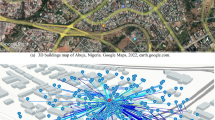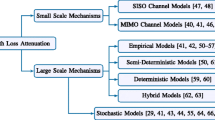Abstract
Microcellular propagation follows different laws than the well-known traditional models, and it is strongly affected by the street and building layout. A well-known and evident phenomenon is the street-corner effect, which consists of a sudden decrease of received field strength as soon as a mobile turns into a side street. Predictions based on ray optics, which can be applied to this case, are accurate but time-consuming. Hence, they cannot be used extensively, e.g., to plan a microcellular network in a city. In many cases, a simplified model would be suitable to give account of field strength behaviour in the transition region between line-of-sight (LOS) and non-line-of-sight (NLOS) propagation, and could be used as a basis of a complete microcellular field prediction tool. Following this approach, we propose a simple parametrical model for propagation around a corner: the parameter values have been tuned to fit the considered environment. The tuning process can be accomplished by means of either measurements or simulations. In order for the model to be as general as possible, it needs a large amount of reference data: for this reason, we used simulations performed with a validated ray-tracing software tool in a variety of situations. These simulations allow one to derive values of the various parameters as functions of the local topology (e.g., street width, distance from the street corner, etc.). The model thus tuned is compared with measurements, showing a good agreement between estimated and measured path loss. This model is shown to behave satisfactorily when compared with measurements, and it is suitable to characterise the street-corner effect in a variety of cases. Finally, this model, along with a simple model for LOS propagation (double slope, with a breakpoint caused by reflections on the ground and on building walls), is aimed at building a complete, modular prediction tool for the microcellular environment.
Similar content being viewed by others
References
E. Green, “Radio Link Design for Microcellular Systems”, British Telecom Technology J., Vol. 8, No.1, pp.85–96, 1990.
J.-E. Berg, R. Bownds and F. Lotse, “Path Loss and Fading Models for Microcells at 900 MHz”, in Proc. 42 nd IEEE Vehicular Technology Conf., Denver, 11–13 May, 1992, pp. 666–671.
J. Wiart, A. Marquis, M. Juy and G. Benoit-Guyod, “Analytical Microcell Path Loss Model at 2.2 GHz”, COST 231 TD(93)56, 1993.
J.-E. Berg, “A Simplified StreetWidth Dependent Microcell Path LossModel”, COST 231 TD(94)35, Lisbon, January 1994.
P. Daniele, M. Perucca, G. Riva and L. Stola, “Propagation Models for Microcellular Environments”, in Proc. VI Italian Workshop on Mobile Radio Systems, Villa Griffone, Pontecchio Marconi, Italy, 27–29 October 1993, pp. 119–136.
P. Daniele, V. Degli Esposti, G. Falciasecca and G. Riva, “Field Prediction Tools forWireless Communications in Outdoor and Indoor Environments”, in Proc. IEEE MTT-S European Topical Congress on Technologies for Wireless Applications, Turin, 2–4 November, 1994, pp. 129–134.
COST 231 Final Report, Chapter 4, 1998.
P. Daniele, M. Frullone, K. Heiska, G. Riva and C. Carciofi, “Investigation of Adaptive 3D Microcellular Prediction Tools Starting from Real Measurements”, in ICUPC '96, Cambridge, Massachusetts, U.S.A., 29 September–2 October, 1996, pp. 468–472.
S.R. Saunders and F.R. Bonar, “Prediction of Mobile Radio Wave Propagation Over Buildings of Irregular Heights and Spacings”, IEEE Transactions on Antennas and Propagation, Vol. 42, No.2, 1994.
Author information
Authors and Affiliations
Rights and permissions
About this article
Cite this article
Barbiroli, M., Degli Esposti, V. & Grazioso, P. Extraction of a Simplified Model for Street Corner Loss in Microcells from Ray-Tracing Simulation. Wireless Personal Communications 12, 225–237 (2000). https://doi.org/10.1023/A:1008854716874
Issue Date:
DOI: https://doi.org/10.1023/A:1008854716874




